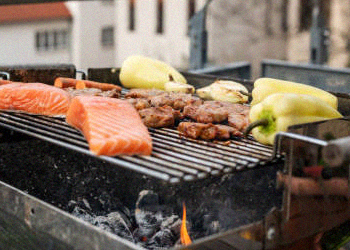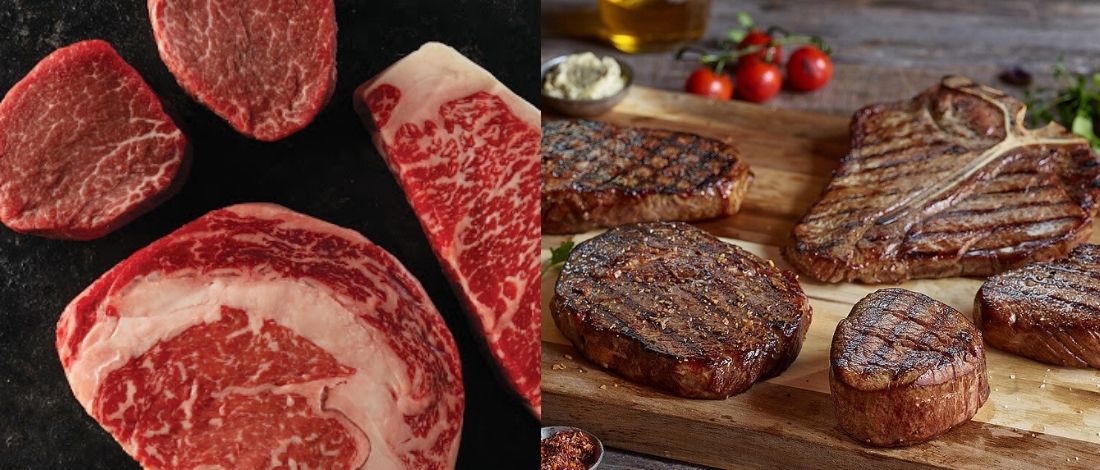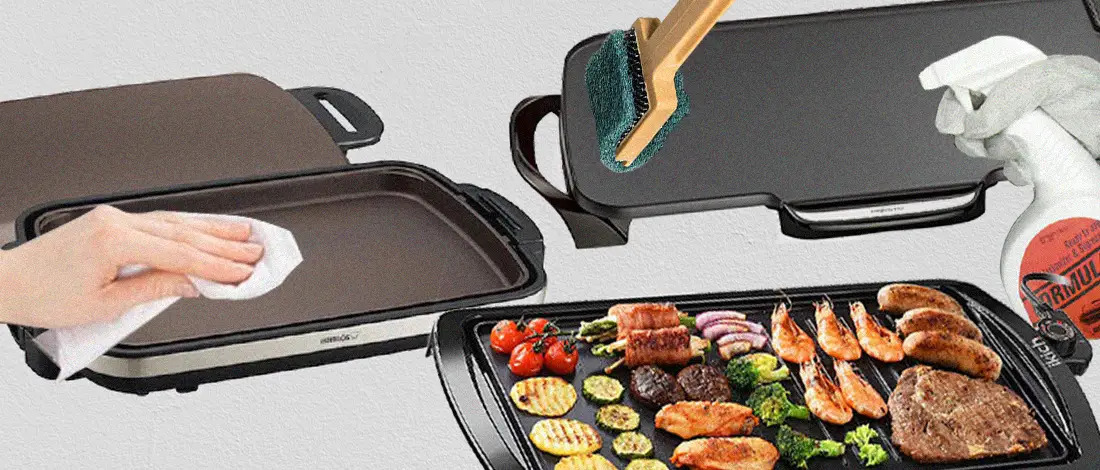If you are new to the grilling world, then you might not understand the difference between a griddle and a grill.
While these two appliances are similar, they have different cooking surfaces, require different techniques, and are suited for different foods.
With our years of experience in the grilling world, we are here to give you an in-depth look at the difference between the griddle and the grill.
Quick Summary
- Griddles have a smooth, flat cooking surface suitable for breakfast foods, while grills have an open grate with a heat source underneath, perfect for cooking meats like burgers and steaks.
- Griddles are made of steel or cast iron, cooking at 350°F; grills cook above 400°F with materials like nickel-plated steel.
- A 2016 study in the National Library of Medicine investigated the effects of grilling and griddle cooking on chicken, finding that these methods influenced the oxidation of thiols, tryptophan, alkaline amino acids, and protein cross-linking, which are critical factors for the meat's nutritional quality and sensory properties [1].
- Griddles are easier to clean with warm water and a scraper, while grills require soapy water and a stiff brush.
What is a Grill?

A grill is the perfect piece of equipment for cooking outside on a nice day. The entire grill's cooking surface consists of an open grate with a heat source underneath it.
Similar to the griddle, grills come in two types: open flame or electric.
You use the grill by placing food directly on the rack. This method doesn’t work for all food but is great for a burger patty, meat, fish, and vegetables.
Traditional grills cook at a higher heat that dries the meat out, which is why many people marinate it to lock in the moisture.
Only use tender meats on a grill such as steak and hot dogs, because they give you the best taste.
“I love the culture of grilling. It creates an atmosphere that is festive but casual.”
- Bobby Flay, Chef, Tv Personality
It doesn’t have flat cooking surfaces but rather raised ridges that leave grill marks on the food. This gives it a unique look that many associate with grilled food. While you can get these marks from using a grill pan, it doesn’t have the same feel or taste as meat cooked on a traditional grill.
What is a Griddle?

A griddle is known for its smooth and flat cooking surface, which is perfectly suited for making breakfast foods like French toast, eggs, and bacon [2].
Some even use its flat cooking space to make grilled cheese sandwiches and quesadillas. You can cook anything that would typically be put in a frying pan on a griddle.
This appliance is similar to a hotplate because its heat source comes from directly underneath and the food is placed right on top of it.
Think of it as a frying pan without the handle or sides.
The majority of electric and stove-top freestanding griddles are rectangular which gives them a large cooking surface.
You’ll find there are specific griddles for indoor, outdoor, home, and restaurant use. It is easy to flip food and won’t trap moisture while food cooking.
Each type of griddle is unique and serves a distinct purpose, but they are all designed to help cook food quickly with its cooking surface. You can even add accessories like the bacon press to collect bacon grease or insert griddles.
What’s the Difference: Griddle vs Grill?
Now that you have an idea about each of these cooking surface appliances, let's take a closer look at how the grill and griddle cook differently.
Type of Metal

The type of metal makes a huge difference in how the cooking surface appliance is heated and how the food cooks.
Griddles for home use are typically made of steel or cast iron. If you need a griddle for commercial use, you’ll get one that is cold-rolled steel or possibly chrome.
The difference in the material relates to weight and heat retention.
If you are going to be cooking burgers and potatoes on your griddle, opt for the thicker steel because it will cook these dense foods better.
Similarly, grills come in a variety of materials ranging from nickel-plated steel to cast iron.
Related Article: What's the Best Stainless Steel Grill?
What Food Can You Cook?

The foods you cook with an appliance like a charcoal grill are different from that of a griddle plate.
Flat griddles are most typically used for cooking breakfast items like scrambled eggs and toast, but it also works great for burgers and hot sandwiches.
There is a use for a griddle in almost every country:
- Spain: Almost everything is grilled at a griddle cooking station
- Indians: Chapati
- Japan: Teppanyaki dishes
- Frances: Crepes and galettes
- United States: Grilled cheeses
- Mexico: Fried rice
Similarly, grills are also a vital part of cultural dishes. A freestanding grill is perfect for cooking larger meat and sausages or whole vegetables.
According to a 2018 article published by the Michigan State University, when cooking on a grill, it is important to add oil, so the food doesn’t dry out and stays tasty [3].
Adhering to the right cooking process means you’ll be able to cook perfectly on a gas burner.
You can add smaller pieces to the grill, but they will need to be skewered not to fall through the grates on the grill.
Temperatures

In the debate of griddle vs grill, you’ll find that temperature is one of the main differences.
Gas grills cook at temperatures above 400 degrees Fahrenheit, while the griddle stays around 350 degrees Fahrenheit.
Charcoal grills, among others, give off a ton of smoke which means it needs to be placed outdoors or in a room with a commercial hood ventilation system.
Griddles are safer because the heat is contained and there aren’t any open flames.
Tabletop griddles and outdoor cooking griddles are better at temperature control, because of the smaller cooking surface. The medium heat on a griddle wouldn’t come closer to the low heat of a barbecue appliance.
Cleaning

You won’t be surprised to hear that a freestanding griddle is much easier to clean than its counterpart.
Most grill grates make it harder to get into the nooks and crannies where burnt grease tends to hide.
To clean it, you’ll need soapy water and a stiff brush. On the other hand, a griddle can be easily cleaned with warm water and a scraper.
Types of Grills
If you are experienced with grilling meats, you know it is a surefire way of getting tasty food. Yet, it can be hard to know which type of grill is right for you. Here are a couple of the most popular types of grills.
- Charcoal Grill - It is easy to use and creates a smokey flavor. Many grillers love the way the temperature stays consistent and is perfect for cooking those tougher cuts of meat.
- Pellet Grill - A convenient and flavorful grilling option because it can be used as both a grill and a smoker. It needs to be plugged in and works best for longer cooks.
- Gas and Propane Grills - Most backyard grillers use this type of gas because it is convenient and heats up fast. Add an accessory to spice your grilling game.
Types of Griddles
You might be shocked to know that there are a ton of different griddles to choose from ranging from the outdoor cooking griddle to Blackstone griddles. Let’s take a look at a few of these griddles.
- Electric Griddle - Portable enough to be moved around the house with a thin surface. Many cooks love the non-stick feature, which makes cleanup fast and easy. You can even place it on top of an existing grill.
- Griddle Pan - This appliance has raised ridges similar to a grill that gives the food beautiful char marks. You’ll find this griddle retains heat better.
- Pancake Griddle - A unique design that makes cooking faster with a cooking temperature that is easily controlled.
How to Clean a Grill

Cleaning a grill takes more elbow grease and time, than a cast iron griddle pan or traditional griddle.
The open flame design means that grease can get stuck in tiny, hard-to-reach places. The way to clean a grill varies depending on the kind you have.
Cleaning a Charcoal Grill
A coal appliance requires the most cleaning because the charcoal ash needs to be wiped away after each use to avoid fire risks.
Begin by brushing out the ash and cleaning the grates with a stiff wire brush, then wipe it down with oil.
Cleaning a Gas Grill
A propane or natural gas grill only needs to be cleaned at the beginning and end of each grilling season. Clean the grates with a stiff-wire brush, then wipe vegetable oil on them to prevent food and rust build-up.
Next, clean the grilling lid and the heat deflectors. Work to remove any grease spots or build-up in the gas ports.
Cleaning a Flat Grill
To clean a Camp Chef appliance, you’ll need to do so when it is hot. Spray a cleaning solution along the flat cooking surface and let it sit for a bit before using a scrub brush to get rid of food debris.
Finally, wipe the whole thing down with a dry cloth and repeat if necessary.
Be sure to read our guide on how to clean a flat-top grill if you wish to learn more.
How to Clean a Griddle

To improve the quality of your griddle cooking, you’ll want to clean the griddle regularly. This will extend its life and keep it in tip-top shape. You’ll need to remove grime and use the right tools.
Create Soapy Mixture
First, try to clean your griddle after each use because that keeps dirt from building up and is the best time to get caked-on bits off.
Warm it to the right temperature that coincides with the type of soap you have. Turn the griddle off once you feel the dirt is loose enough.
To wipe down the griddle, you’ll need to create a soapy solution that is a mix of water and dish soap.
We highly recommend soap specifically designed for griddles because it makes the process easier.
Do not submerge the griddle in soapy water because that might damage the electricals.
Wipe Down the Griddle
Now, dip your sponge into the warm soapy water and begin scrubbing at the griddle top.
Continue to dip the sponge into the warm water to make sure each part of the griddle surface is getting a good coating. Remove the insert griddle to get a deeper clean.
Season the Griddle
After cleaning off the grim, you’ll want to season your griddle. This ‘seasoning’ or protective coating is used to prevent rust.
To do this, simply pour a teaspoon of olive oil onto the griddle and use a paper towel to spread it around.
Once the oil has sat for an hour, wipe away the excess oil from the griddle top.
Read More: Tips to Cleaning an Electric Griddle
References:
- https://www.ncbi.nlm.nih.gov/pmc/articles/PMC5055878/
- https://www.dictionary.com/browse/griddle
- https://www.canr.msu.edu/news/to_marinate_or_not_to_marinate








